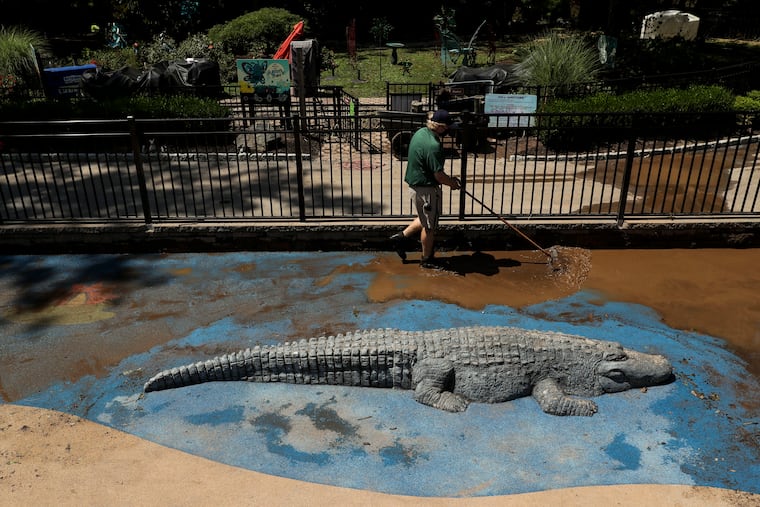Do zoo animals freak out in a tropical storm?
Storm-prep is an arduous task for area zoos. At Elmwood Park, it involved moving a 200-pound American alligator named Penny who can be dangerous to humans.

Early Tuesday, just before Tropical Storm Isaias tore through the region, staff at the Elmwood Park Zoo in Norristown directed Penny, a 200-pound alligator, to walk into a crate, and then carried her uphill to safety.
They also moved 30 other animals — including giraffes, bobcats, snakes, and wild birds — to emergency shelters farther from the creek. Once inside, Minnow, a brown Pygora goat, hopped onto a log to try to keep her hooves dry.
Water quickly started pouring into the zoo, said Eric Donovan, its director of operations, and ultimately flooded half of the property.
“I’ve never seen flooding like this before,” he said. But because the zoo was prepared, no humans or animals were injured, he said, and the zoo was able to reopen Thursday.
Zoos face unique challenges when bracing for tropical storms and other inclement weather. While property damage is hard to prevent, staff members take steps to keep animals safe and comfortable.
On Tuesday, the Philadelphia Zoo and the Cape May County Zoo made it through the storm without major incidents. Elmwood Park, however, sits along the Stony Creek, which connects to the Schuylkill not far from the zoo, and was hit harder.
The storm preparation process was “arduous” and “chaotic,” he said, but “well-handled.”
Around 7 a.m., zookeepers and other employees began to move the dozens of animals to indoor, back-of-house accommodations uphill, he said.
» READ MORE: Isaias’ aftermath brings a massive cleanup at flooded homes, prolonged outages, and a closed Vine Street Expressway
Relocating each animal comes with its own set of challenges, Donovan said.
Moving Penny — that 200-pound American gator — took some serious coordination. Fortunately, he said, staff had trained her to go into a crate. Once she was secured inside it, staff could take her to a vacated jaguar exhibit, which was protected from flooding due to its elevation. It was a worthwhile effort, he added: Penny’s home was completely flooded.
The moving process took less than two hours, Donovan said, and the rest of the morning was spent waiting for the storm to pass. When it did, staffers emerged to survey the damage, start the cleanup, and figure out new exhibits for displaced animals.
Down the Shore, the Cape May County Zoo — which considers itself “lucky” not to have suffered serious damage from Isaias — knows the animal relocating dance well.
» READ MORE: In South Jersey, ‘panic mode’ as tornado came out of Strathmere and tore up Route 9
Any time even thunderstorms are in the forecast, “we lock all of our animals,” said Alex Ernst, a veterinarian at the zoo.
“For our zoo, and most zoos out there, all animals have indoor, secure housing,” he said. But “on a standard day, if there’s no bad weather predicted, they’re outside all day.”
Because the Cape May County Zoo is not near any rivers, staff are more concerned about protecting animals from high winds or falling trees, not flooding, Ernst said.
However, during severe storms, “Cape May County is at risk of the bay and the ocean meeting,” he said, and the zoo did worry about flooding before Hurricane Sandy in 2012.
For the New Jersey zoo, the worst part about Tuesday’s storm, Ernst said, was the “mess” of fallen trees and branches and the hours the animals had to spend confined.
Do any freak out or cower as storms rage outside, like pets do? “Wild animals tend to instinctively not have any major concerns with weather,” he said. “For the most part, they’re more upset about having to be locked into the indoor area.”
In Norristown, Elmwood Park Zoo staff and volunteers were left to fix extensive property damage and clean up the mess made by the region’s second whopper of a storm in the last two months.
During the derecho that struck in early June, the zoo lost two dozen trees and four buildings, as well as its zip line courses, he said. On Tuesday, exhibits were crushed, a shed was destroyed, small trees and branches were downed, and debris was everywhere.
This latest storm comes a little more than a month after the zoo reopened from the three-month coronavirus shutdown, he said, and will make economic recovery even more difficult. The 96-year-old zoo has turned to the community for help, asking for donations and for volunteers to assist with cleanup.
On Wednesday, staff and volunteers were able to remove hazards in walkways, neaten up the public areas, and get animals situated in temporary exhibits, he said, so the zoo could reopen. But, he said, much work remains.